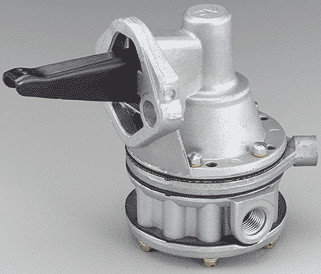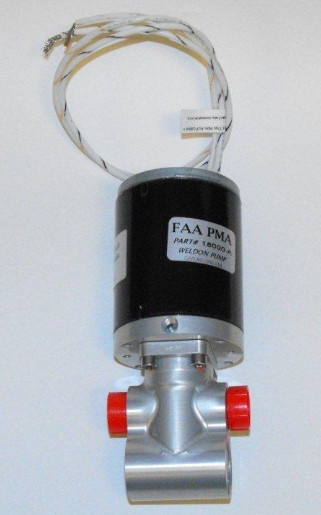I’d guess Lance N. and company borrowed the Dragonfly fuel delivery design (single pump to header tank, then gravity feed) without considering injected engine issues. The first Lancair had an O-200 engine and the next an O-235, neither engine is available with injection.
Looking at the document, the default setup seems to be engine driven pump + electric backup, taken from the header tank. Then transfer pump(s) from the wing tanks to the header tank.
The Australian guy I linked to made his own setup with a valve, so the engine driven pump could take fluel from either the header or each wing tank. In addition he had transfer pumps. I don’t know what the common setup is amongst Lancair owners/builders, but if I were to build one, I would think in directions of simply removing the header tank altogether. Having a header tank in the cockpit if there is no good reason for it, seems like a strange thing to do. If you need the extra range, I would simply gravity feed the header into the wing tanks instead. But then, maybe there are some CoG issues here also?
I am not sure the probabilities are comparable.
Normally you have the engine driven fuel pump. If that fails (which is very very rare) you switch on the electric one. To get the failure of the former, plus a failure of the latter, would be amazingly bad luck (unless the latter was duff before the flight, which would be truly dumb, and it would be very hard to start the engine).
With the header tank system, you don’t have the engine driven fuel pump, but when the tank runs low, you turn on the electric one and find it has failed, what do you do? You have only a single point of failure, plus whatever fuel is in the header tank when the failure of the electric one is discovered. One would really need two pumps to refill the header tank, to get an equivalent reliability. Or, if you want to make a trade, you could top off the header tank when it is say 90% full, and then a failure of the single pump would still leave you with 90% of 30 mins (or whatever).
What I still don’t get is the fuel injection scenario. How do you feed the RSA fuel servo? There must be another pump in there somewhere, with a spring loaded bypass so as to deliver a constant pressure. OR a return to the wing tanks. OR most likely the IO320 has the normal engine driven pump, like most Lyco engines have.
Googling suggests the fuel servo needs 20psi which is way more than the head from a header tank.
Peter wrote:
Also 20-30 mins is cutting it close if you are over the Alps.
Yes, but it’s a lot better than 2 seconds.
That would seem to be OK for a carb engine (where only a minimal head is needed to feed the carb which has its own float valve) but how would it work for a typical fuel servo for say an IO320 which needs a lot more fuel pressure?
Gravity never fails but you don’t have an inverted fuel system this way so can’t fly upside down (for long) unless you keep +ve G 
Also 20-30 mins is cutting it close if you are over the Alps.
Peter wrote:
What is the reason for the header tank, when there are plenty of planes with same or similar engines which just suck the fuel up with an engine-driven fuel pump?
Not sure the exact reason on the Lancair, but the general reason is to have gravity feed of the fuel to the engine. Gravity never fails, so you have no direct dependence on fuel pumps. A transfer pump failure will give you at least 20-30 minutes of endurance.
The Dragonfly home built had a similar header tank arrangement with a single fuel pump and about 45 minutes range on the header tank. It worked pretty well and eliminated one pump.
The fuel circulated continuously in that system, maintaining a constant level in the header tank without any action from the pilot. If the header tank fuel level dropped for any reason, you landed.
What is the reason for the header tank, when there are plenty of planes with same or similar engines which just suck the fuel up with an engine-driven fuel pump?

and have an electric one as a backup

Even if the header tank refill was automated you would still need two electric pumps, because if one fails you will likely have insufficient endurance to reach the nearest airport, and an off-airport landing in one of these types is not a great idea.
Peter wrote:
Presumably therefore if you didn’t know about the header tank, the engine will stop when the header tank empties?
Yes, so it seems. If you forget about transferring the fuel to the header, it will run dry in an hour or so. It wouldn’t be too difficult to make an automated system, but the more I think about that header tank, the more odd the whole concept seems. If you absolutely need that extra 8 gallons, it would be better to transfer (by gravity) from the header tank to the main tanks instead, and run a normal setup from the mains. There are two Lancairs here at ENVA. One of them, a 235 has this header tank setup. He told me he always fills it up before shutting down so he don’t have to use battery power alone to transfer fuel before starting. The other, a 320, I’m not sure what he has. The 320 is a considerable heavier engine than a 235, maybe the COG would prevent a 320/320 from using a header tank?
Googled this accident report from Australia. It is a bit interesting.
The aircraft was constructed by an owner-builder in Western Australia from a kit
purchased from the manufacturer in the US. The builder fitted a type-certified9
Textron Lycoming O-360 engine and type-certified MT-Propeller MTV-12 variable
pitch propeller. The kit did not contain a stall warning device and the builder did
not fit one. There was no regulatory requirement for a stall warning device.
The builder reported that the aircraft was constructed in accordance with the kit
plans except for a few changes that included modifying the fuel system. In the
standard fuel system, a header tank located between the cockpit and engine was the
only tank that supplied fuel to the engine. When the header tank quantity decreased,
the pilot transferred fuel from the left or right wing tank to the header tank by
activating electric pumps. The builder reported that he had been concerned that with
a standard fuel system, a pilot could forget about the need to transfer fuel to the
header tank.
The builder modified the standard fuel system by incorporating a fuel selector
(figure 5) and fuel lines that allowed the engine to be supplied directly from the
header tank or either wing tank. An electric pump and fuel lines were also fitted to
allow transfer of fuel from the left wing tank to the header tank. The header tank
had a maximum capacity of 41 L and each wing tank had a maximum capacity of
80 L.
The aircraft builder reported that he operated the aircraft with the header tank
selected for takeoff and climb, and selected a wing tank during the cruise phase of
flight. Information relating to the nature of the modification and the proposed
method of operation was not included in any aircraft documentation.
The aircraft was equipped with a plastic-tube sight gauge as the header tank fuel
quantity indicator. The fuel level evident in the plastic tube corresponded with the
quantity of fuel in the header tank. There were marks identified adjacent to the
plastic tube, but no scale marked. An electronic instrument provided fuel quantity
indications for the left or right tank.
A copy of the Pilot’s Operating Handbook and Airplane Flight Manual
(POH/AFM) produced by the kit manufacturer for Lancair 235, 320 and 360 aircraft
was carried in the aircraft. It contained the following fuel management information:
Do not takeoff with less than 8 gallons [30 L]10 in the header tank. Since the
engine is supplied fuel solely from the header tank, fuel must be transferred
from each wing tank to the header tank periodically
The minimum fuel instruction was also placarded on the aircraft’s instrument panel
(figure 6). According to the aircraft kit manufacturer, the 8 gallon minimum for
takeoff was to ensure that pilot had adequate fuel for takeoff and climb, and was to
keep the aircraft within centre of gravity limits.
The POH/AFM fuel management information and instrument panel placard did not
apply to the system in VH-ZNZ because fuel was not supplied solely from the
header tank.
Presumably therefore if you didn’t know about the header tank, the engine will stop when the header tank empties?